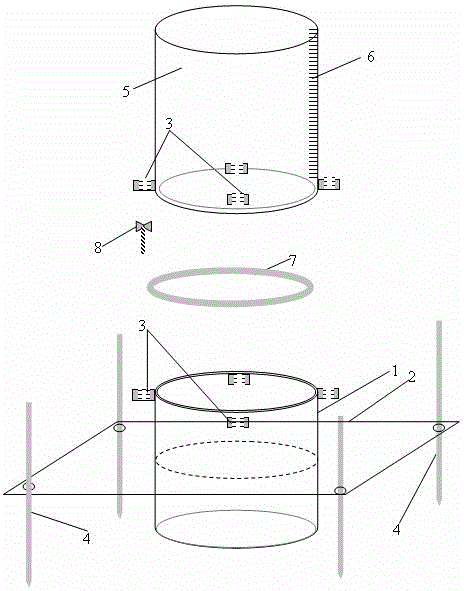In-situ monitoring device for self-purification capacity of pollutants in shallow water area
A technology of self-purification ability and shallow waters, which is applied in the direction of testing water, general water supply saving, material inspection products, etc., can solve the problems of in-situ quantitative standardization research that affect the self-purification ability of pollutants, and achieve in-situ quantification and standardization , less human interference, easy to use
- Summary
- Abstract
- Description
- Claims
- Application Information
AI Technical Summary
Problems solved by technology
Method used
Image
Examples
Embodiment Construction
[0007] Further illustrate the present invention below in conjunction with accompanying drawing
[0008] refer to figure 1 , the in-situ monitoring device for the self-purification ability of pollutants in shallow waters of the present invention includes a lower fixed sleeve 1, an upper detachable sleeve 5 and a sealing device connecting the upper and lower sleeves; the lower fixed sleeve 1 and the upper detachable sleeve The sleeves 5 are transparent cylinders with open bottoms and tops. The lower fixed sleeve 1 is covered with a transparent rectangular plastic plate 2 that can slide up and down. Small holes are respectively set on the four corners of the transparent rectangular plastic plate 2. Each Respectively pass through a stainless steel rod 4 in the small hole, the diameter of the stainless steel rod 4 is the same as the small hole diameter, the upper peripheral surface of the lower fixed sleeve 1 has grooves, the lower opening is knife-edge shape, and the inner wall of...
PUM
 Login to View More
Login to View More Abstract
Description
Claims
Application Information
 Login to View More
Login to View More - R&D
- Intellectual Property
- Life Sciences
- Materials
- Tech Scout
- Unparalleled Data Quality
- Higher Quality Content
- 60% Fewer Hallucinations
Browse by: Latest US Patents, China's latest patents, Technical Efficacy Thesaurus, Application Domain, Technology Topic, Popular Technical Reports.
© 2025 PatSnap. All rights reserved.Legal|Privacy policy|Modern Slavery Act Transparency Statement|Sitemap|About US| Contact US: help@patsnap.com

